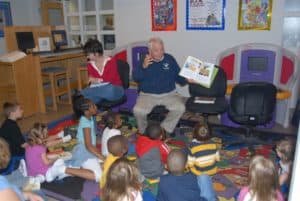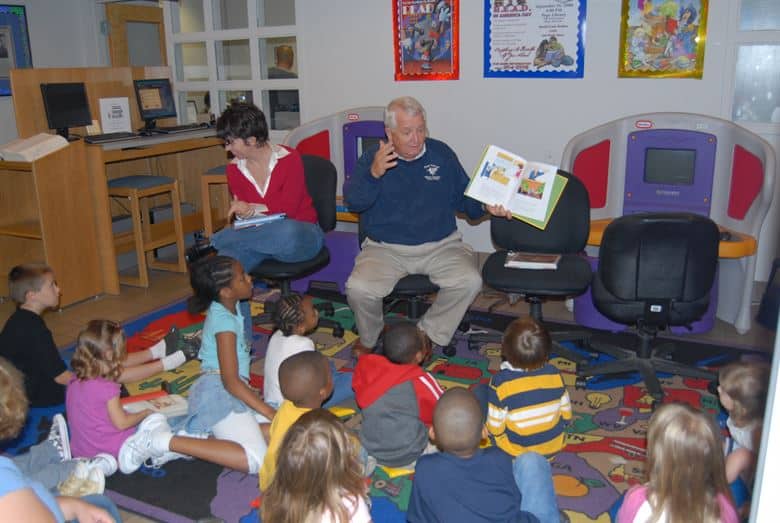 If you’re reading this, you can definitely read! Congratulations! So why do you need advice on how to be a good reader? Reading aloud, especially to children, is skill that looks deceptively easy but requires a great deal of finesse to do well. We are in the age of the “guest” or “mystery” reader. It’s quite common now for relatives to be invited into a classroom setting to read aloud. In the Children’s Room, I field many questions from terrified grown-ups about what books they should read to their child’s or grandchild’s class.
If you’re reading this, you can definitely read! Congratulations! So why do you need advice on how to be a good reader? Reading aloud, especially to children, is skill that looks deceptively easy but requires a great deal of finesse to do well. We are in the age of the “guest” or “mystery” reader. It’s quite common now for relatives to be invited into a classroom setting to read aloud. In the Children’s Room, I field many questions from terrified grown-ups about what books they should read to their child’s or grandchild’s class.
Recent studies show strong evidence that reading aloud to children of all ages is critical to maintain literacy skills, even for children who are independent readers. Many adults forget the joy of being read to and stop reading aloud to children once they can read themselves. As parents, we are all crunched for time, but making time for bedtime stories is important for several reasons. Reading provides a wonderful bonding time between parents and children, which older children still crave.
Reading aloud to older kids also whets their appetites for stories they might struggle to read on their own. According to Jim Trelease in his book, The Read Aloud Handbook, children’s reading comprehension skill doesn’t catch up with their ability to listen and process information until around 8th grade. By exposing kids to exciting characters and plots while broadening their vocabulary, parents’ reading aloud feeds their appetite for stories and helps with comprehension.
Practice makes perfect, and preparation is the key to feeling comfortable in front of any group. Once you get a few techniques down, you’ll feel more confident reading to a class or to a child in your life. Here are my top tips for success:
Consider your audience: The first step is choosing the right book to read. Think about the age of the children you’ll be reading to and what interests and attention span they have. Are you reading to a toddler classroom or a group of 4th graders? Don’t panic if you aren’t up to date on the latest picture book titles or children’s literature trends; that’s our job at the library! Younger children do best with basic story lines, large, clear illustration,s and predictable outcomes. Older kids still love picture books as well, but can handle more complicated themes and often respond better to more subtle humor. This is why toddlers and preschoolers adore classics like Bill Martin’s Brown Bear, Brown Bear, What Do You See and Chicka Chicka Boom Boom. Older kids can appreciate Drew Daywalt’s Legend of Rock, Paper, Scissors or The Day The Crayons Quit.
Be thorough: Once you select the right material, read through it silently and then aloud. Notice any natural pauses or rhythms to the text. Notice any humor and how you might vary your pace for the best delivery. DO NOT wait to read the book until you are in front of your audience. I can guarantee crowd pleasers like Don’t Let the Pigeon Drive The Bus or The Book With No Pictures will go over well, but not if you don’t get the timing right.
Practice, Practice, Practice: There’s no getting around this one. The best way to get better at reading aloud is to simply do it. I personally cannot read aloud to thin air, so I often pull in a colleague or my husband to be my audience. As you read aloud, watch for audience reactions. If the person you are reading to isn’t laughing or looking on thoughtfully at the right spots, you may need to try again. Reading with expression is also important. Speaking in a monotone voice, especially when reading dialogue between characters, is the fastest way to lose a child’s attention. If you feel confident enough, try out different voices for different characters to help kids differentiate who is speaking.
Slow Down: I’m a fast talker. Most of us who were raised in the Northeast are used to speaking with a clipped accent. Fast talking is very efficient and great for everyday conversation, but it is a hindrance when trying to read aloud. Great readers can build drama and tension through pacing, and if you are reading too quickly your words will get lost. We tend to speed up when we are nervous or in front of an audience. Even if you think you are reading slowly, you are probably reading too fast. Practice also helps with slowing down.
Reading aloud is a powerful skill beyond the classroom. It’s not as highly valued as it once was, but an audience will immediately appreciate your hard work when you are able to deliver a story, Bible verse or poem with ease. It’s also an excellent way to communicate ideas and values, especially the love of reading. For more on the power of reading aloud and how it can improve your own reading, please check out Jim Trelease’s book The Read Aloud Handbook from the library today.
Kate Tigue is Head of Youth Services at the Morrill Memorial Library in Norwood, MA. Look for her article in the March 28, 2019 issue of the Norwood Transcript.




